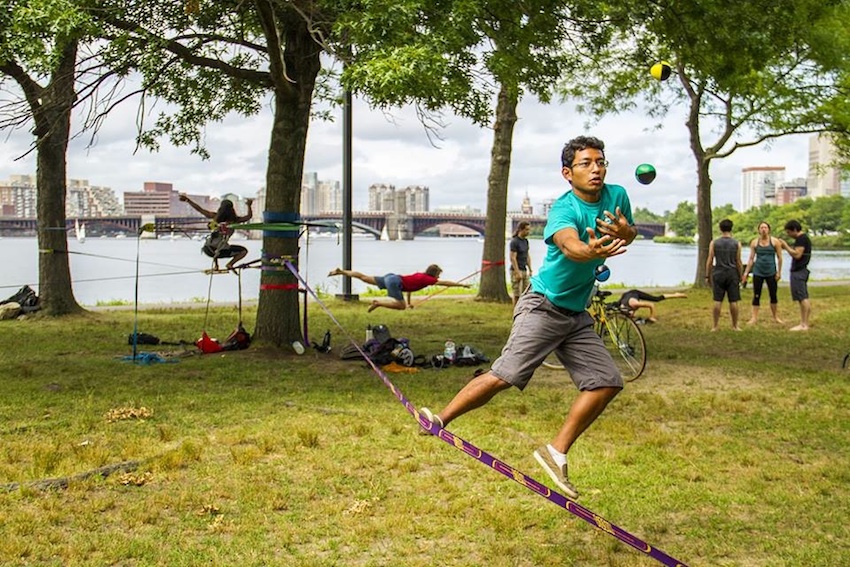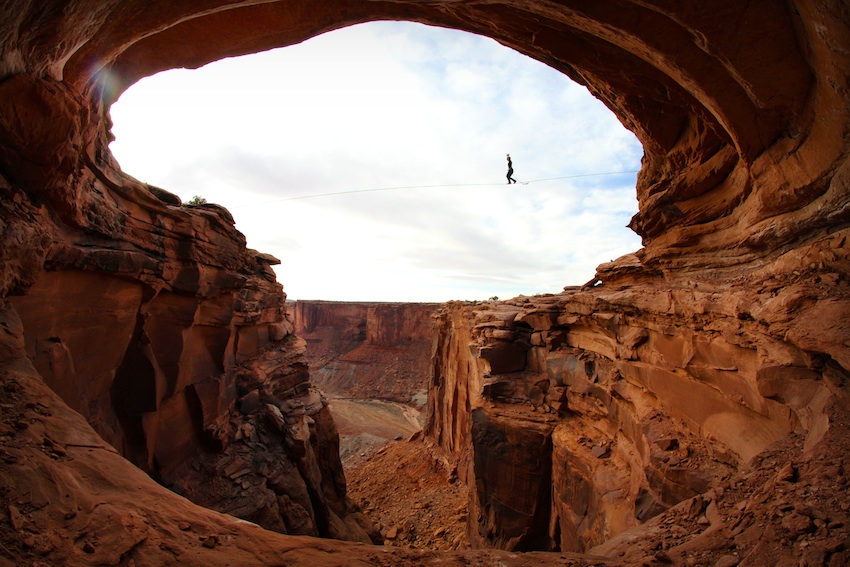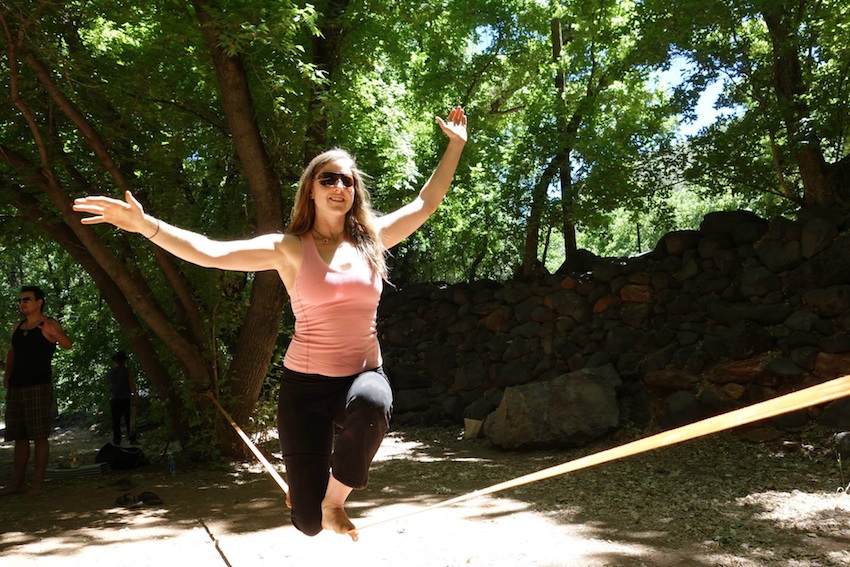Slacklining: Walking A Tight Rope At The Esplanade
Sonya Iverson focuses on a spot straight ahead of her as she makes her way across the taunt, thin strap tied to two trees. Maintaining a steady pace, she pushes herself through a variety of tricks before reaching the other side of the line and hopping off, going virtually unnoticed by the smattering of runners who make their way down the Esplanade’s paved paths. Iverson, a Boston University graduate student, isn’t a tight rope walker in the circus. However, she’s practicing the art of something closely related to the circus stunt: slacklining.
Typically, slacklining involves walking across a taunt polyester or nylon line that is anchored to two strong objects. It differs from tight rope walking only in the fact that slackliners use lines that are not completely taunt, which requires extra balance. According to Iverson, slacklining started as something that rock climbers did while they were hanging out at camp, but it has slowly become more widespread. “Slackliners are usually people who love doing something that is silly, but that’s also very difficult,” says Iverson, the founder of Boston’s slacklining group. “Slackliners are often people who love doing something with no bigger purpose than to conquer a challenge.”
Slacklining workouts often attract yogis who are tired of practicing yoga in a studio and daredevils looking for some thrill-seeking fun. Iverson says that slacklining can vastly improve your balance, and walking a line requires core strength. “You have to use your abdominal muscles to stay on the line,” she says, “and your leg muscles are often sore after practicing.” The meditative aspects of slacklining are also healthy, and many slackliners say that the practice has made them more self-confident and less anxious.
Chip Fieberg, an avid participant in acroyoga and a slackline instructor, loves the meditative calm that he feels after finishing a slacklining practice. “There’s a psychology to slacklining because you have to stay focused. It’s a great meditation tool. If your mind is all over the place, you can’t do it,” he says. “When you’re calm and breathing and focused, the magical moment happens. Everything stands still. That’s how people get hooked on slacklining.”
Slacklining can involve a variety of different activities: long-lining with lines that are often hundreds of feet long, high-lining with lines that are hundreds of feet above the ground, water-lining over bodies of oceans, lakes, and ponds, trick-lining (when people complete flips and tricks on nylon lines, which allow for bounce), and even acroyoga on slacklines. Here in Boston, Iverson has created an online community of more than 300 individuals who participate in slacklining on a regular basis. You’ve likely seen the group practicing at the Hatch Shell on Sundays, and on the Esplanade by Boston University during other days of the week.
“I came to Boston from Montana where I was involved with slacklining,” Iverson says. “I set up a line in the park here because I didn’t know anyone in Boston, and that’s how I met people. We started telling people that it was a club, and then the community grew. Every Sunday, around 30 people come to play. It’s basically a bunch of graduate students and a few professionals walking tight ropes and being silly. It’s awesome, and my social circle here is my slacklining crew.”
Although slacklining may seem intimidating, Fieberg maintains that the activity is accessible to anyone who is willing to give it a try. He and his wife, Laura, travel the country teaching slacklining acroyoga classes to anyone who signs up, and he says that in a 90-minute class, almost everyone in the workshop will be able to stand on the line no matter what their physical fitness levels may be.
“We teach people exercises on the ground and then they try them on the slackline,” he says. “We then take them from a kneeling position on the line into a standing position, which helps them to build both confidence and skills. We start people on a polyester line because it involves less bouncing.” Fieberg says that it is typical for a beginner to only achieve standing on the line by the end of the class. “That’s a big win, though,” he says. “In rare cases, a quick learner will be able to do a warrior pose on the line. But it’s mostly standing.”
Slacklining is an adrenaline rush and both Fieberg and Iverson agree that your mood and your level of focus can make or break a slacklining practice. If you’re in a bad mood, Iverson says that you won’t be able to perform well on the line. “Slacklining teaches you a lot about yourself,” she says. “We always joke that it’s a straight forward sport because you literally walk in a straight line. And if you keep moving, you’ll be okay, just like in life. But it also forces you to meditate, calm down, and focus.”

A member of the Boston slackline community walks the line at a practice on the Esplanade. Photo via Boston Slackliners Facebook.

A Boston slackliner attempts to catch a ball while balancing on the line. Photo via Boston Slackliners Facebook.






